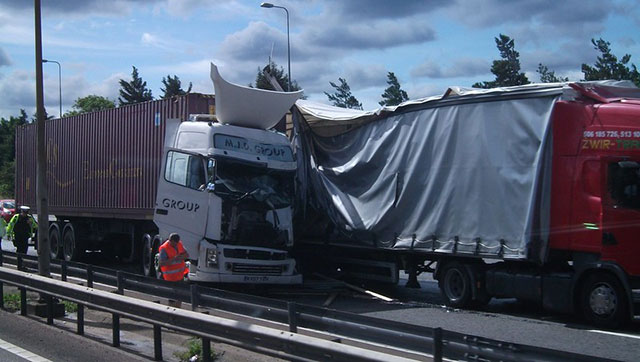Truck accidents can have serious consequences often resulting in serious injuries, fatalities, and extensive property damages. Typically, these accidents are more severe than car accidents. Although truck drivers are usually highly trained and experienced, accidents can still happen due to various factors including driver fatigue, distracted driving, and equipment malfunction.
Table of Contents
How to Avoid Truck Accidents

Fortunately, there are steps drivers can take to reduce the risk of getting into an accident.
Keep a Safe Distance
It is critical to maintain a safe distance from trucks in order to avoid accidents. Trucks require a longer distance to stop than passenger vehicles as they are much larger and heavier. Divers should keep a following distance of 4-6 seconds behind trucks to allow enough to react if the truck suddenly stops or swerves. A larger vehicle limits a car driver’s vehicle ahead; therefore, it is important to leave plenty of room to incase there is a sudden stop.
Stay out of Blind Spots
Trucks have large blind spots on all sides. Drivers should avoid blind spots in the front, back, and sides, and they should always stay visible to the truck driver. A trick to know if you are in the truck driver’s blind spot – look at the truck’s side mirror. The truck driver cannot see you if you cannot see their face. Try to pass on the driver’s side of the truck as they have a much wider blind spot on the passenger side. When passing a truck, do so quickly and safely, and signal any intentions clearly.
Be Alert and Focused
It is important to avoid distractions such as texting, eating, and adjusting the radio while driving. Drivers need to be aware of their surroundings, including other vehicles, road conditions, and weather. It is important to use turn signals when changing lanes or turning and to avoid any sudden or erratic maneuvers that would catch other drivers off guard.
Understand Truck Limitations
Trucks have limitations that drivers should be aware of including limited visibility, longer stopping distances, and slower acceleration. Avoid cutting trucks off or merging abruptly in front of them, and make sure to give them plenty of space. Drivers should be patient when behind a truck as passing them can be dangerous and should only be done when it is safe to do so.
Practice Defensive Driving
Defensive driving involves anticipating potential hazards on the road and taking proactive steps to avoid them. It is important that drivers always be on the lookout for potential hazards, such as reckless drivers, road debris, or adverse weather conditions. They should be prepared to react quickly if a hazard arises by either slowing down or changing lanes.
Stay Calm and Present
Although driving can be incredibly stressful, it is important to stay calm and patient to avoid accidents. Drivers should avoid engaging in road rage and other aggressive driving behaviors such as tailgating or honking their horns excessively. It is important to avoid using one’s phone and messing with the radio. Instead, drivers should take deep breaths and remain focused and alert.
Truck accidents can have severe consequences, and drivers should take steps to reduce the risk of getting into an accident. No matter how cautious drivers are, accidents still happen as one cannot prevent everything. Getting into an accident can be scary and overwhelming, and it is a good idea for injured drivers to speak with an attorney who can help navigate the post-accident process. However, reviewing these tips can help to prevent an accident. It is important to remember that safe driving is everyone’s responsibility, and both car and truck drivers play a role in keeping our roads safe.













